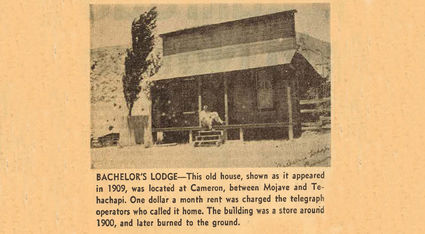Tehachapi Telegraph Operators
A Page of History
March 2, 2019

Photo provided
BACHELOR'S LODGE - This old house, shown as it appeared in 1909, was located at Cameron, between Mojave and Tehachapi. One dollar a month rent was charged the telegraph operators who called it home. The building was a store around 1900, and later burned to the ground.
Operators kept the major tracks open between Tehachapi and Bakersfield near the turn of the century. Searching my mother Marion Deaver's history files yielded an article from August 20, 1956 outlining the job of telegraph operators for the railroad.
According to the article, the men who ran the telegraph only referred to themselves as operators, since everyone knew the guy who operated the telegraph key was the "operator."
There were two such operators who ran the telegraph keys from the early 1900s until they both retired. Clyde Mallachowitz and Frank Nejedly helped keep the rails open when there was only a single track between the two cities.
Tehachapi was considered one of the heaviest train order jobs in the United States until 1944 when central traffic control over the hill eliminated all the mountain telegraph jobs. Almost 95 percent of the jobs were train orders with the remainder being railroad messages and Western Union messages.
Tehachapi handled all traffic between Mojave and Tehachapi and Tehachapi and Bakersfield, and with the heavy loads, was one of the most important spots in the division.
In the early days of single track across Tehachapi, more than 100 train orders could be worked in eight hours before telephones were installed in 1910.

There were times when there would be 10-15 helper engines waiting in Tehachapi for orders to return to Bakersfield. Sometimes it took four or five engines to bring trains up the grade to Tehachapi, and it could take 10-12 hours. In 1956, diesels were able to make it in one fifth of that time, the article noted.
Tonnage in the early days was 1,500 (thousand pounds) but in 1956 the trains could haul 8,700. When the operators first began they stayed in an old house, shown as it appeared in 1909. The building was located between Mojave and Tehachapi at Cameron. The house was later used as a store, and later burned to the ground.
During winters in Tehachapi, it was necessary for the operators to go out and sweep the snow out of the switches. Later they used gasoline torches for the job. If I had written this article two weeks ago we might have thought that they got much more snow 100 years ago. These last two weeks have seen the snow return to Tehachapi "like it was 40-50 years ago," according to every old timer I ran into this week.
Now as the railroad has begun its double tracking project between Tehachapi and Bakersfield, it is probably a good thing that orders are sent through computers. The old operators might not be able to keep up these days.



